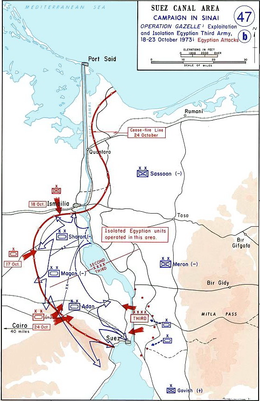Battle of Ismailia
| Battle of Ismailia | |||||||
|---|---|---|---|---|---|---|---|
| Part of the Yom Kippur War/October War | |||||||
 Map showing Operation Abiray-Lev, including the Israeli attack north toward Ismailia |
|||||||
|
|||||||
| Belligerents | |||||||
|
|
|
||||||
| Commanders and leaders | |||||||
|
Abd el-Munim Khalil Ismail Azmy Ali Heikal Osama Ibrahim |
Ariel Sharon Amnon Reshef Haim Erez Danny Matt |
||||||
| Strength | |||||||
| One paratrooper brigade Two commando battalions |
One armored division: Two armored brigades One paratrooper brigade |
||||||
| Casualties and losses | |||||||
| unknown | unknown | ||||||
The Battle of Ismailia took place between the Egyptian Army and the Israeli Defense Forces (IDF) during the last stages of the Yom Kippur War during October 18–22, 1973, south of the city of Ismailia, on the west bank of the Suez Canal in Egypt. The battle itself took place as part of the larger IDF-launched Operation Abiray-Lev, in an attempt to seize Ismailia and thereby sever the logistical and supply lines of most of Egypt's Second Field Army across the Suez Canal.
Breaking out of their newly established bridgehead west of the Canal at the northern end of the Great Bitter Lake, the IDF launched an offensive from Deversoir toward Ismailia. A combined force of Egyptian paratroopers and commandos fought a delaying battle, falling back upon defensive positions further north under increasing pressure from IDF infantry and armor. By October 22, they were occupying a last line of defense, including positions along the Ismailia canal. Though outnumbered, they repulsed a final Israeli effort to capture the city; a United Nations ceasefire was then imposed, bringing the battle to an end. The Egyptians registered a tactical and strategic victory in the defense of Ismailia, stopping an encirclement of their large forces on the east bank of the Suez Canal and ensuring their supply lines remained open.
On October 6, 1973, Egypt launched Operation Badr, which started the Yom-Kippur War. It succeeded in crossing the Suez Canal and establishing bridgeheads on the east bank in Israeli-occupied Sinai, and counter-attacks launched by Israeli reserves were unsuccessful. By October 10, fighting along the front had come to a lull. Egyptian President Anwar Sadat soon ordered an offensive to seize the strategic Sinai mountain passes, despite protests and objections by his senior commanders against such an offensive. Sadat hoped to divert Israeli pressure from the Syrians. The October 14 offensive was ill-planned and ill-executed, and culminated in heavy Egyptian losses without achieving any objectives.
...
Wikipedia
